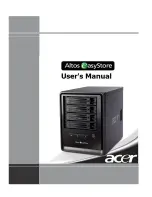
If there is no response when you press the KVM select button, you can use the
Advanced-Management-Module Web interface to determine whether local control
has been disabled on the blade server. See http://www.ibm.com/systems/
management/ for more information.
Notes:
1.
The operating system in the blade server must provide USB support for the
blade server to recognize and use the keyboard and mouse, even if the
keyboard and mouse have PS/2-style connectors.
2.
If you install a supported Microsoft Windows operating system on the blade
server while it is not the current owner of the keyboard, video, and mouse, a
delay of up to 1 minute occurs the first time that you switch the keyboard,
video, and mouse to the blade server. All subsequent switching takes place in
the normal KVM switching time frame (up to 20 seconds).
Media-tray select button:
Press this button to associate the shared BladeCenter
unit media tray (removable-media drives) with the blade server. The LED on the
button flashes while the request is being processed and then is lit when the
ownership of the media tray has been transferred to the blade server. It can take
approximately 20 seconds for the operating system in the blade server to recognize
the media tray.
If there is no response when you press the media-tray select button, you can use
the Advanced-Management-Module Web interface to determine whether local
control has been disabled on the blade server.
Notes:
1.
The operating system in the blade server must provide USB support for the
blade server to recognize and use the removable-media drives and front-panel
USB ports.
2.
If you install a supported Microsoft Windows operating system on the blade
server while it is not the current owner of the keyboard, video, and mouse, a
delay of up to 1 minute occurs the first time that you switch the keyboard,
video, and mouse to the blade server. All subsequent switching takes place in
the normal KVM switching time frame (up to 20 seconds).
Activity LED:
When this green LED is lit, it indicates that there is activity on the
external storage device or network.
Location LED:
The system administrator can remotely turn on this blue LED to aid
in visually locating the blade server. When this LED is lit, the location LED on the
BladeCenter unit is also lit. The location LED can be turned off through the
Advanced-Management-Module Web interface or through IBM
®
Director Console.
For more information about the Advanced-Management-Module Web interface, see
http://www.ibm.com/systems/management/. For more information about IBM
®
Director, see the documentation on the IBM
®
Director CD that comes with the
server, or visit the IBM
®
Director Information Center at http://
publib.boulder.ibm.com/infocenter/director/v6r1x/index.jsp.
Information LED:
When this amber LED is lit, it indicates that information about a
system event in the blade server has been placed in the Advanced-Management-
Module event log. The information LED can be turned off through the
Advanced-Management-Module CLI, SNMP, or Web interface or through IBM
®
Director Console. For more information about the Advanced-Management-Module
Web interface, see http://www.ibm.com/systems/management/. For more
14
BladeCenter HS22V Type 7871 and 1949: Installation and User's Guide
Summary of Contents for BladeCenter HS22V
Page 1: ...BladeCenter HS22V Type 7871 and 1949 Installation and User s Guide...
Page 2: ......
Page 3: ...BladeCenter HS22V Type 7871 and 1949 Installation and User s Guide...
Page 70: ...54 BladeCenter HS22V Type 7871 and 1949 Installation and User s Guide...
Page 90: ...74 BladeCenter HS22V Type 7871 and 1949 Installation and User s Guide...
Page 94: ...78 BladeCenter HS22V Type 7871 and 1949 Installation and User s Guide...
Page 102: ...86 BladeCenter HS22V Type 7871 and 1949 Installation and User s Guide...
Page 106: ...90 BladeCenter HS22V Type 7871 and 1949 Installation and User s Guide...
Page 107: ......
Page 108: ...Part Number 60Y1598 Printed in USA 1P P N 60Y1598...















































